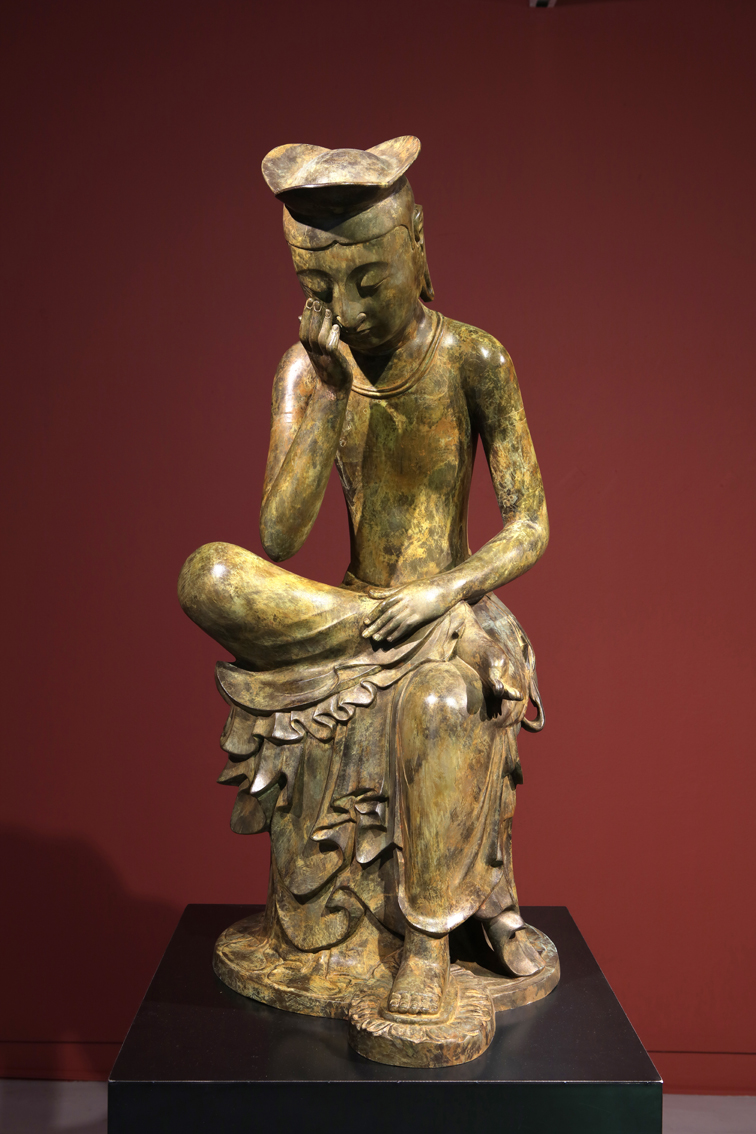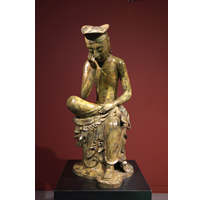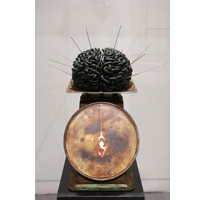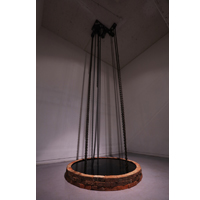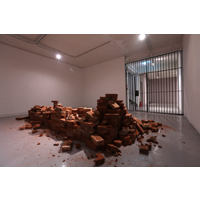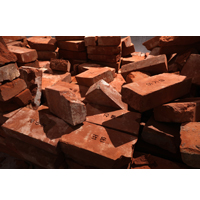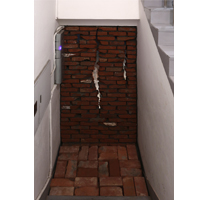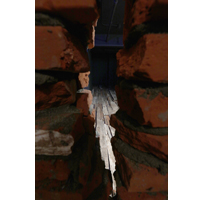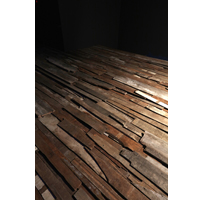.jpg)
Seung Young KIM, Savina Museum of Contemporary Art
Birth
1963, Seoul
Genre
Sculpture, Installation, Photography, Media, Performance
Homepage
Fragmentary Memories: Imagining Communication beyond Space and Time
Artist Seung Young Kim, has addressed the themes of communication and memory in installations and site-specific work. One such work features waterdrops falling at regular intervals from the ceiling to the floor heaped with fallen leaves collected from a forest; and another is a video projection showing names of people with whom the artist shared his life. Kim's work vividly represents fleeting moments of encounters, waiting, and the meaning of existence with its inherent memories. His work offers viewers the pleasure of experiencing a new world by making their sense of sight, hearing, touch, and smell fully operate in between the contact point of space and time, blurring the boundaries between past and present, matter and soul, man and nature. Those who come to his exhibition are invited to engage in conversations on the clandestine, yet essential value of being during the momentary encounter with matter and void space that creates a lingering resonance. Through this dialogue, the viewer will come to understand how an everyday object enters the domain of art and how it operates within our daily lives, away from its everyday context.
The incorporation of everyday objects and merchandise into the realm of art discourse, and twisting their original context is a technique often adopted by Dadaists, Surrealists, and Pop artists. Their employment of this technique aimed to bring about an extremely artificial and shocking effect using the 'readymades' - products of new information and technology in the industrial age. This act was an outgrowth of the progressive view of art history, produced from an artistic discourse that was based on the Western 'reason-centered' value system.
However, Seung Young Kim's transgression from the ordinary, and his original presentation effects share to some extent the same context as his predecessors above, but is fundamentally different in its vision. Kim's work appropriates the products of capitalist industrial society, skirting its superficiality or banal representations of society. His appropriation of everyday life borrows from daily urban life, but he also tempts at an abstruse meaning of life, and traces of cultural heritage (possibly discovered by chance at a serene Buddhist temple remote from day to day wear).
Kim's work reminds us of the dignity and mysticism of fresh life forms discovered in unknown plants and insects. Like relics, his work recalls traces of human life and the weight and meaning of cultural memories. It also illustrates clear dewdrops formed on leaves of grass, and produces the sound of a wind chime suspended below eaves. Such elements have magical power to revive our senses of sight, hearing, touch, and smell. His work does not ride on modern artistic discourse that highlights visual truth or physical elucidation of art, or Marshal McLuhan's concept of the age of electronic technology.
Kim's work elucidates for us the sage’s wisdom and raison d'etre of the fundamentals of being which precedes any dichotomies between nature and civilization, reason and sensibility, intellectual and perceptual worlds.
Young-Soon KIM (Art Critic)
A New Tower of Babel
Today’s art world, caught in the rapid current of trends, has become relatively younger and more interesting than before. However, despite quantitative growth, it is rare to find an art work that has a serious approach and steady attitude toward a consistent topic. Art observers are often left with a sense of dissipation. In the flood of new artists and exhibitions, we may encounter various concepts and spectacles, but actually it has become harder to find art works that touch us deeply. And in some cases, works that show sincerity often look conceptually and formally old fashioned, as if they are just a re-run of old music and thus not a proper alternative. This is the area where the leading artists’ role is stressed. In this aspect, Seungyoung Kim’s exhibition at the Sabina Art Museum drew attention. Distinct from the younger generation, with his weighty artistic experiences, he presents a modernistic progress in his areas of long-time interest: memory and communication.
In this exhibition, we gain a sense of the context of the artist’s practice as shown through works from earlier group exhibitions, open studio programs, etc. Further this exhibition offers a chance for us to think about how, in recent works, he has approached and represented his areas of interest. Although he had solo exhibitions recently in Strasbourg and Vancouver, as well as at Weibang Gallery and Space Gallery in Korea, it is the first time since his 2003 solo exhibition in Hyeri that we can gain a full appreciation of his recent practice. In this near-retrospective, he presents sound installation, media art and sculpture. And amongst these, the installation of speakers occupying the first floor seems the most outstanding. Tower consists of 186 used speakers piled up to the ceiling, creating a huge structure. From each speaker, sound designed by sound artist Yoonsuk Oh flows out. Since Kim’s first sound installation work at Weibang Gallery in 2007, he has shown consistent interested in the concept of experimental work that enables the viewers to experience a sense of space in three dimensions through sound. A Wall in Platform, 2009 at Kimusa, another speaker installation work that used a wall, was also produced along these lines of interest.
These works are probably not totally irrelevant from the recent sound art trend; however it would be more correct to look at Kim's work in the context of his overall practice rather than as an experiment in a particular genre or medium. In his sound installation work Sweeping for “Sound Effects Seoul 2010” exhibition at Space Hamilton, he displayed nothing but a sweeping sound in an empty space. The space was filled with a resonating sweeping sound in a manner that made the existence of the space stand out more and made viewers imagine an unknown past or personal histories related to the particular space. After all the non-existence of objects and events was emphasized. And the sweeping sound felt as if it beckoned the cleaning all remnants of the past. It even felt like our everyday stress was being swept away. By presenting an aesthetics of release rather than accumulation, the cleanness of this work remains one of the most beautiful sound art installations I have ever experienced.
Nothingness is the basis of the aesthetics of Kim’s work. Contemplation of the point where inactivity and infinity meet, a consciousness of extinction that has formation and coexistence, is the starting point of Seungyoung Kim’s art. Another work that drew my attention in this exhibition at the Sabina Art Museum is Strasbourg. This film contains a scene of some ruins that betray a sort of vanity of extinction and power created through the accumulation of time a realization made by the artist during his residency in Strasbourg. In front of a ruined cement wall, there is a dead bird and next to that a commercial advertisement billboard that keeps moving indifferently. It is an implicative scene of life and death, human and nature. In “Les iles”, Jean Grenier wrote, “Nobody has to tell me about the frailty of the world. I have already experienced something more that the world is already empty.” Influenced by this essay, Cloud presents an abundant image that can be very transient through the movements of endlessly changing clouds, and it seems as if the emptiness is not about the state of not having anything but the state of revealing life as if it were without weighty desire.
Nature scenes have often been points of departure in Kim’s contemplation. In this sense, reflection, a title that he often uses, can be interpreted literally as reflections and projections of the elements of nature, such as water, light or shadows, and at the same time signifies his own introspection. In Memory Room, an installation work done in Heyri in 2003, the artist's introspective tendency is even more visible. A circle of old book shelves surrounds a calm pool of water, the sound of water dropping from the ceiling to the calm surface of a water pool in the middle. This work realized a tranquility that can only be experienced in a quiet mountain temple, and here silence means a state of repose that makes us accept ‘the presence of what is there at the moment’, not a phenomenon of absence. It is a moment where we experience life including death in its original form. Indeed, since Kim’s introspective work brings momentary experiences such as communications between cognition and infinity; it is only completed through the viewer’s own experience of the site. The sound of water drops that make quiet waves on the water surface guides the viewers to an inner experience that is both very personal and completely universal. It gives a sensation that we can feel from the sound of wooden percussion at a Buddhist temple in a mountain in the early morning.
When looking into the process of the changes in the artist’s work over time, his work has evolved from a contemplation of nature to self-introspection, and from introspection to communication with others. Chair in this exhibition utilizes the heating chair that his mother used to use in winter, and in this participatory work, viewers are invited to sit and experience the warm temperature, which is set to body temperature: 37 degrees. I get stressed out when I have to use all my interpretational knowledge in order to understand contemporary art exhibitions, but in this work, I felt very comfortable and relaxed and even did not want to leave the chair. The reason why the Kim’s work does not come across as unnecessarily emotional or stale despite the fact his work is relatively quick to the emotional response is because it is based on the fundamental human condition of solitude, not on personal sentiments.
Using walls and speakers his recent sound installation works tackle universal communication rather than personal memories, and it all started with his interest in the Tower of Babel. The Tower of Babel is a metaphor for a state of disconnected communication between different languages, however, through his work Kim attempts to produce a different level of language that is decoded through a mixture of various sounds and voices coming from speakers. This language consists of the sounds of heartbeat, signals and flying birds; sounds that are not included in the territory of conventional language but rather occupy a realm of abstract language that can still transpire between humans. The voice in Hello from his exhibition at Weibang Gallery, 2007 was the voice of a father reading a lullaby to his son, and there what is important was not the contents of the reading, but the low and kind voice of the father and the rhythm of his lullaby.
In front of Tower, the pile of speakers, we hear muttering sounds that are hard to decipher. One might feel confused in front of the mixture of these irregular sounds, but at the same time he or she may be able to feel vast narratives of life that cannot be expressed in existing languages, as though standing in front of the wall of an ancient temple. Here life is a territory that cannot distinguish between yours and mine: it is a more original form where humans are simultaneously individual and communal beings. Communication between humans who have never met or who use different languages may be possible in this life. Maybe that is the future of Babel, the image of Babel in an era of new media.
Eunjoo Lee (independent curator, art historian)






